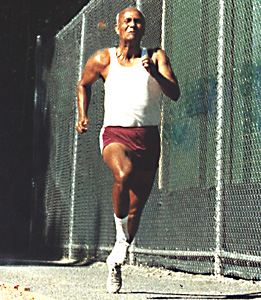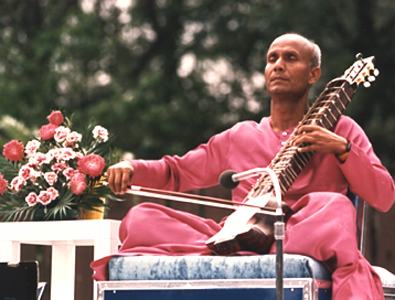June 19841
One group of runners that not only competes in races but also organises them for other runners of all standards is the Sri Chinmoy Marathon Team. Though Sri Chinmoy races are known widely throughout Australia as some of the best organised and friendliest runs around, not much is generally known of the man who is the inspiration behind these events.
It was during 1979 that the name of the Sri Chinmoy Marathon Team first appeared in running calendars around the country. In the cities of Brisbane, Melbourne, Adelaide and Canberra, runs organised by the SCMT became a regular feature, encouraged by Sri Chinmoy’s interest and participation in long distance events. Sri Chinmoy’s involvement in running is not, however, only a recent undertaking – his athletic career spans a lifetime of active endeavour.
As a youth, Sri Chinmoy was heralded as a champion athlete in the area of South India where he lived. He held Ashram records for 100 metres, 200 metres and the decathlon – his best for 100 metres being 11.7 seconds.
Then, as now, life was for Sri Chinmoy a balance of active sport and meditation. To him, these early days of intense spiritual practice and athletic discipline were important in shaping his philosophy that in later years became the basis of his work in the West.
Nowadays, Sri Chinmoy can be seen, any morning, in the New York suburb of Jamaica Hills, practising his sprints and training for veterans’ championships. This quiet, tree-lined portion of the borough of Queens is just a few blocks away from the harsh backdrop of the parts of New York usually portrayed in media images. It is in this city of contrasts that Sri Chinmoy chose to start his spiritual mission, which has now grown internationally.
It has been 20 years since he first left India to be of service to the Western world. For the first few years in America, Sri Chinmoy held a job at the Indian Consulate, while he worked ceaselessly in his spare time towards manifesting his spiritual vision by giving free lectures, meditations and holding concerts.
These days life is only a little different, in that he can easily support himself as an author, but the same enthusiasm and dedication is still very much in evidence. His former boss at the Indian Consulate, Ambassador L.L. Mehrotra, spoke of Sri Chinmoy at a concert just a few years ago:
He brings to you a spiritual tradition which sprang and flourished in the mountain-vastness of the Himalayas several thousands of years ago and which is carried across the seven seas by Everest streams and rivers. Sri Chinmoy is part and parcel of that eternal stream. Sri Chinmoy belongs to that stream of thought and sentiment, which has shown us the light for ages.
 |
 |
|
|
Sri Chinmoy practises sprints in preparation for the World Masters Games, 1983. |
In concert, Sri Chinmoy plays meditative music on the esraj.2 |
Each morning at 4 a.m. Sri Chinmoy meditates on his disciples. At around 6.30 to 7 a.m. he is already heading to the track for warm-up sprints; afterwards, he will use his exercise machines at his tennis court.
Tennis is one of Sri Chinmoy’s favourite sports. He often plays non-stop for hours, once playing as many as 453 games in one day. However, during the week there are usually more urgent matters that require his attention. To guide over 60 spiritual centres throughout the world is more than a full-time job. Twice a week he will travel to Manhattan to deliver lectures and meditations at the United Nations. More often than not, he will discuss spiritual aspects of the world’s problems with ambassadors and UN delegates.
He is also fond of meeting with people from every country who have excelled in their field. He greatly admires the significant contributions that so many people have made to the world, especially when their influence for good has extended well beyond their chosen vocations – athletes like Emil Zátopek, the immortal Czech distance runner; and Jesse Owens, hero of the 1936 Berlin Olympics; as well as musicians like Leonard Bernstein, composer and conductor; and Pablo Casals, the virtuoso cellist.
He loves diversity, but has a single aim – to spread peace wherever and whenever he can – and each minute of his day is packed with commitment. After a busy daily schedule, some evenings there is perhaps still time to hold a public meditation or concert.
He manages to blend a respect for the physical world with the aspiration for a higher reality. His teachings and his life express a call for the integration of inner reflection and outer dynamism: “In the heart of action, is the silence of meditation, and in the heart of meditation, is the dynamism of action,” says Sri Chinmoy.
The notion of the integral development of the human being is not wholly a new concept to western culture. The Greek philosophers looked upon the perfection of man as the highest attainment of mind, body and spirit. And the ‘Renaissance Man’ was meant to be strong, intelligent, artistic and noble of character.
Perhaps modern man, who has become so specialised, has lost the sense of overall, integral perfection. Two thousand years of Western civilisation has culminated in an overpowering material society, but it has left many devoid of purpose.
When we look at the past decade, it is running that has offered hundreds of thousands of people a new challenge in life, a chance to become masters of themselves, to break with the bondage of a static and sedentary way of life.
Sensing this growing need for self-expression and self-transcendence, Sri Chinmoy responded by asking his disciples to organise events for runners to provide more opportunities where they could freely enjoy open, friendly competition.
It is the athletic traditions of each nation that seem to point towards a common goal for mankind. Runners in their thousands are taking to the roads, some training with the dedication of Olympians. Never before in the history of the world have so many earned the right to be called athletes.
For every outer runner there is an inner runner – the soul of man striving to manifest perfection, to bring to the fore the complete universal man:
Your days of excellence-joys
Are ahead of you
And
Not beside you.
Why, then, do you not
Immediately run and declare:
THE GOAL IS WON!
– excerpt from the poem ‘ The Goal Is Won’ by Sri Chinmoy
In self-transcendent action, Sri Chinmoy is consistently challenging the ‘impossible’. He is a talented writer and poet with over 500 books to his credit. One of his recent accomplishments was to write 10,000 poems, which have now been published in 100 volumes entitled Ten Thousand Flower Flames. The first poem in this volume describes his experience in the New York City Marathon, which he has run several times. He compares the marathon race to the challenge of writing 10,000 poems:
One marathon-world
Leads me into another marathon-world.
To satisfy this new marathon-world,
Or to be satisfied by this new one, will be
Infinitely – I really mean it –
More difficult.
For here it is not just twenty-six miles
And 385 yards to run,
But to sow the seeds
Of ten thousand flaming flower-poems…
– excerpt from the poem ‘A New Marathon’ by Sri Chinmoy
He is currently writing a volume entitled Twenty-Seven Thousand Aspiration-Plants.
In the field of art, his painting stands as a monumental achievement. To date over 140,000 paintings have been catalogued. 120,000 of them were created in a one-year span.
His talent flows into the world of music as well. He is a composer and an accomplished musician. Typically, his output is immense and his music displays a refreshing quality not found in many modern composers.
The great conductor Leonard Bernstein was moved to declare, “What power is in this man’s music! It’s incredible … I am very, very deeply impressed.” And in a letter to Sri Chinmoy, he wrote, “You are a miraculous model of the abundance in the creative life that we lesser mortals seek, and I can only hope that I may some day participate in that cosmic fountain of stillness and profound energy, which you inhabit.”
In a sense, the volume of Sri Chinmoy’s work is overwhelming. That one man can do so much is hard for the mind to comprehend. Yet this is perhaps a point Sri Chinmoy subtlely states – that the mind can only comprehend part of the reality and the body experiences only part of the reality. It is the inner person, which can be known and will one day be revealed, that knows the universal and limitless reality.
– End –
Endnotes:
1 This article was first published in Guide to Brisbane Running magazine, pages 16-17, June 1984.
2 As part of an international concert tour, entitled ‘Peace: God’s Beauty in His Oneness-Home’, Sri Chinmoy gave 20 free performances in major cities, including Melbourne (Australia) on September 12th, 1984. He also performed in Los Angeles during the time of the Olympic Games.
Copyright © 2008, Animesh Harrington.
All rights reserved under Creative Commons license.
